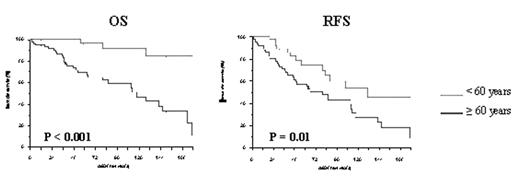Abstract
Orbital NHL (ocular and/or adnexal involvement) represents less than 1% of all lymphomas but about half of malignant tumors of the eye and/or ocular adnexae. We therefore reviewed all patients treated at the Institut Curie between 1970 and 2003 for a NHL exhibiting initial orbital localization to define their initial characteristics, natural history and prognostic factors. Among 172 patients, 145 cases with completed datas were selected for the study. Pathological review according to the WHO classification showed 52 cases of MALT-type lymphoma (36%), 32 lymphoplasmocytic lymphomas (22%), 14 patients with lymphocytic lymphoma, 7 cases of follicular lymphoma, 13 unspecified low grade lymphomas [namely, 118 cases (82%) of low grade NHL], 22 patients with diffuse large B-cell lymphoma (15%), 2 cases of mantle cell lymphoma, 2 Burkitt’s lymphomas and one T-lymphoblastic lymphoma [namely, 27 cases (18%) of high-grade NHL]. Initial characteristics were: median age 66 years (range 3–96), sex ratio M/F 0.6, B symptoms 6%, PS≥2 in 4% of patients, stages III–IV 31.7%, bone marrow involvement 12%, elevated LDH in 18% and IPI 0-1/2/3/4-5 in 92/28/13 and 1 cases, respectively. Anatomic localizations were intra-orbital in 39 patients (27%), conjunctival in 38 (26%), eyelid in 9 cases, lachrymal in 8 and other in 8 cases. Treatment of selected patients consisted of abstention in 2 cases, surgical complete resection in 5 cases, mono or polychemotherapy alone (CT) in 4 cases, and radiotherapy alone in 98 cases (68%) or with CT in 36 cases (25%). With a median follow-up of 90 months (range 3–314), the 5-year relapse-free (RFS) and overall (OS) survivals were 64% and 79% for the low-grade NHL, and 43% and 50% for the high-grade NHL. Prognostic factors were determined for the 118 low-grade patients. In univariate analysis, age greater than 59 years, elevated IPI score and elevated LDH level were prognostic for lower RFS and OS. In multivariate analysis, age greater than 59 years was the only prognostic factor for both lower RFS and OS (Figure 1). In conclusion, with a median follow-up of 7.5 years, our large monocentric cohort of patients represents one of the most important series that defines the initial characteristics, natural history and prognostic factors of NHL with initial orbital localization.
Author notes
Corresponding author


This feature is available to Subscribers Only
Sign In or Create an Account Close Modal